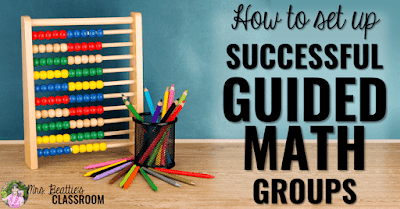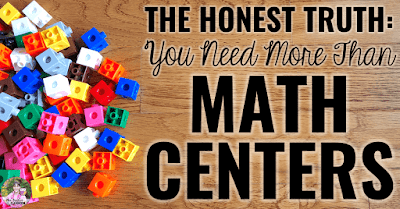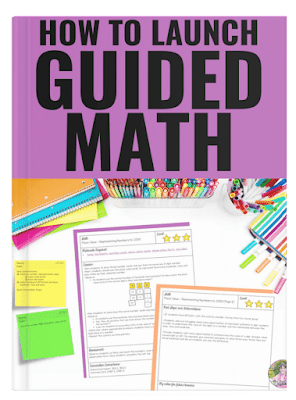The goal of Guided Math groups is for you to have the time to teach focused lessons to small groups of students while the rest of the class is engaged in independent practice activities.
If you want this time to go smoothly and be interruption-free, you need to be prepared.
Training is a Must
The first reason your Guided Math groups may not be working is that your students require training.
Just like any other routine that you introduce to a class, the Guided Math structure that you expect students to follow must be explicitly taught.
You need to clarify:
- When students are allowed to work together.
- What level of noise you expect.
- How and when students may access math manipulatives and other tools.
- What happens if they need to use the washroom or get a drink.
- What students should do if they finish their work.
- What they should do if they don't understand the task.
- Who to get help from if needed.
Resist the temptation to rush your students through this stage to get to covering the curriculum. If you spend the time at the beginning of your program setting up these expectations, the rest of your year will go beautifully!
Consider Group Dynamics
Guided Math groups can be created in several different ways.
You might group your students by ability or place them in heterogeneous groups. Perhaps you strategically place certain students together or plan carefully to keep others apart.
Group dynamics is a critical piece of the Guided Math puzzle.
If you don't have students grouped together in a way that they can work together to accomplish a common goal, then there's a good chance you'll have problems.
You can read more about how I set up my Guided Math groups in this blog post:
Anticipate Potential Problems
Good teachers anticipate the potential problems that may arise at any point in the school day when they're planning their lessons. It is a smart practice to be prepared for anything the day may throw at you!
The same is true for Guided Math groups.
Before you welcome the students each day, take the time to consider what problems you may have and what the possible solutions could be. Remember, you should be focused on a small group lesson during the time your students are working in their groups.
- Think students will struggle with the task? Pre-teach the activity to a strong student, or find a student in the class who will be able to help others.
- Students tend to get off task? Keep them accountable with a system like this one.
- Endless train to the restroom? Be sure to have a solid system for breaks already in place so you aren't interrupted.
- Will students need a particular tool to complete their tasks? Be sure to have all the required supplies ready ahead of the period beginning.
You're Using The Wrong Activities!
If you're having trouble getting Guided Math groups to work smoothly, there is an excellent chance that you're using the wrong activities!
Kids naturally love to work with peers on hands-on, engaging activities, so if you're just pushing paper at them or giving them the same type of activity day after day during their small groups, it is no wonder they're off task.
The Guided Math activities you choose to use with your students should:
- Be easy enough for students to manage independently.
- Incorporate hands-on manipulatives when possible.
- Be varied and provide some choice - a very powerful motivator!
- Give you the peace of mind that your students are practicing valuable math skills independently while you're targeting specific curriculum expectations in your small-group lessons.
When I was teaching Grade 2/3, I created my own Guided Math centers because I didn't have any other resources that really accomplished what I wanted them to.
These have been used by first-grade through fourth-grade teachers with hundreds of positive reviews. You can take a closer look at these right here:
Management System for Behavior Issues
You may have done the group training, considered the students who are grouped together, have provided amazing resources, and you're still having issues.
In cases like this, it is vital to have some sort of classroom management strategy in place.
In my experience, focusing on rewarding the positive behaviors of the students who are on-task is far more effective than calling out someone disruptive. Still, the conversation needs to be had with that student at some point as well.
- Discuss privately what you expect and what the consequences will be if the undesirable behavior continues.
- Keep parents in the loop with a phone call home to explain the problem.
- Remember that behavior is often an avoidance technique for a student when they perceive the work to be too difficult. Do you need to better explain the activities? Would the student benefit from having a better partner? Does the child need some one-on-one time with you to look at the tasks to bolster their confidence?
I've found that small-group instruction tends to decrease the behavior issues rather than increase them, so a little thinking about WHY the student is acting out is essential.
Bonus Thought...
It is also important to consider WHY you are teaching using a Guided Math structure.
If you're placing centers in front of your students and calling that teaching, forgive me, but you're off the mark.
Guided Math is about teaching the curriculum to a small group while your other students are engaged in authentic, meaningful practice with centers.
To read more about this, take a look at this blog post:
If you're looking for more information about Guided Math and how to get started, be sure to grab my FREE Guided Math Quick-Start Guide:
You may also check out the Guided Math Frequently Asked Questions at the top of my blog and contact me here at any time if I can answer any other questions!
If you have enjoyed this post, please share it with friends and colleagues on Facebook or pin it on Pinterest:

























.png)



No comments
Connect with me!! I love reading your comments and will respond as soon as I can!
Note: Only a member of this blog may post a comment.